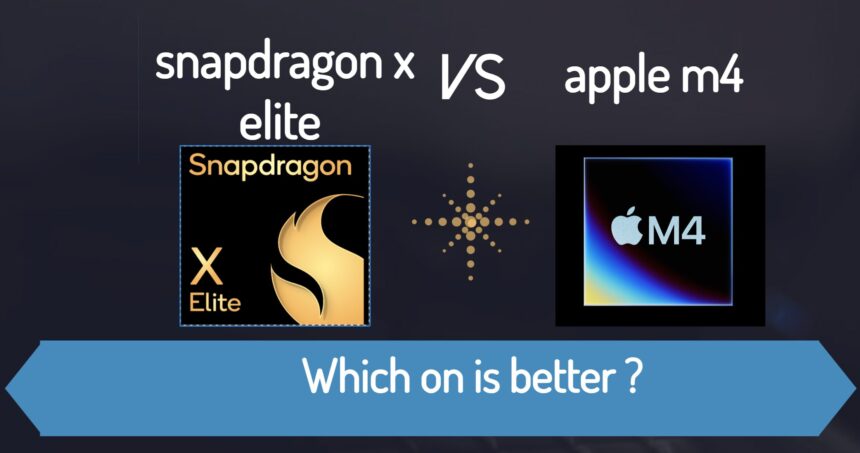The world of mobile processors is a battleground for performance and efficiency. In one corner, we have Apple’s in-house designed M-series chips, reigning supreme in laptops with their impressive power and battery life. In the other corner, Qualcomm’s Snapdragon line has long dominated the Android smartphone market. But with the rumored arrival of the Snapdragon X Elite, things are about to get interesting, especially for Windows laptops looking to challenge Apple’s dominance.
So, the question on everyone’s mind: which chipset reigns supreme? Is this a David and Goliath situation, or can the X Elite hold its own against the mighty M4? Buckle up, tech enthusiasts, because we’re diving deep into a comparative analysis of these two giants.
M4: The Refining Reign
Apple’s M-series chips have been a game-changer for laptops. The M4, the successor to the highly acclaimed M3, is expected to build upon that success. Here’s a peek at what the M4 might bring to the table:
- Architecture: The M4 is rumored to be built on a cutting-edge 3nm process, resulting in smaller transistors and potentially even better performance and battery life compared to the M3’s 5nm process.
- CPU Cores: Leaks suggest a 10-core configuration, likely divided into high-performance and high-efficiency cores for optimal power management.
- Clock Speeds: Early reports indicate a potential base clock speed of 4.41 GHz, pushing the boundaries of single-core performance.
- Graphics Power: The M4 is expected to boast an integrated GPU with improved performance for tasks like video editing and casual gaming.
Snapdragon X Elite: A New Challenger Emerges
Qualcomm’s answer to Apple’s M-series is the upcoming Snapdragon X Elite. This chip, designed specifically for high-performance laptops, aims to bridge the gap between mobile processors and desktop-grade power. Here’s a look at its potential specs:
- Architecture: The X Elite might utilize a 4nm or even a more advanced 3nm process, offering increased efficiency and performance compared to previous Snapdragon chips.
- CPU Cores: There are rumors of two variants: an 8-core and a 12-core option. This could cater to different performance needs in laptops.
- Clock Speeds: Leaked benchmarks suggest clock speeds around 3.4 GHz to 3.8 GHz, potentially lower than the M4 but with the possibility of higher sustained performance due to different architectures.
- Graphics Power: The X Elite is expected to come with a powerful integrated Adreno GPU, aiming to compete with integrated solutions from Intel and AMD.
The Performance Showdown: Benchmarks and Beyond
While official benchmarks for both chips are yet to be released, leaks and educated guesses paint a preliminary picture. Here’s a breakdown of what we might see:
- Single-Core Performance: Early signs point towards the M4 having a significant edge in single-core tasks due to its potentially higher clock speeds. This could translate to faster responsiveness in everyday tasks.
- Multi-Core Performance: The X Elite’s higher core count (in the 12-core variant) could give it an advantage in multi-threaded workloads like video editing and demanding software.
- Graphics Performance: Both chips are expected to offer significant improvements over their predecessors. However, determining a clear winner will depend on specific benchmarks and the types of workloads involved.
It’s Not Just About Raw Power: Efficiency Matters Too!
While raw processing power is crucial, a chip’s efficiency is equally important for battery life. Here’s where Apple’s M-series chips have historically shined. Their tight integration between hardware and software allows for exceptional power management, leading to impressive battery life in Apple laptops.
Qualcomm has been making strides in efficiency, but it remains to be seen if the X Elite can match the M4’s prowess in this area.
Who Should Choose Which? Compatibility is Key
The choice between these chipsets ultimately boils down to your needs and what devices you prefer.
- For Apple Fanatics: If you’re a die-hard Apple user who prioritizes seamless integration between hardware and software, coupled with exceptional battery life, the M4-powered MacBook will likely be your ideal choice.
- For Windows Enthusiasts: The X Elite opens doors for a wider range of laptop options running Windows. This caters to users who prefer the flexibility and customizability of the Windows ecosystem. Additionally, if raw multi-core performance for demanding tasks is your top priority, the X Elite might







